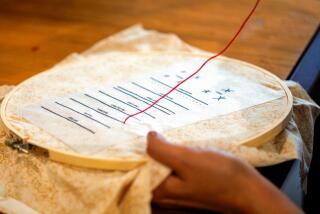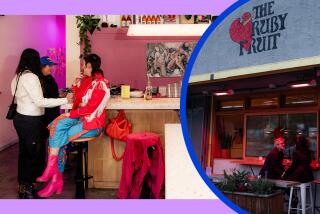Steppingstone From Kitchen to University : School Helps Tap Women’s Potential
- Share via
In the summer of 1963, the San Fernando Valley was a stifling hot and restless place for Chris Edwards, Diane Rosner and Lynn Selwyn, three married women with near-grown children and a desire to challenge themselves artistically and intellectually.
Rosner, a psychiatric counselor, had met Edwards and Selwyn, who are sisters, while hosting discussion groups for women at her Valley home. From these sessions and their common desire for a challenge, the idea for Everywoman’s Village was born.
In the beginning, Everywoman’s Village was geared toward housewives who learned how to paint and dance. As the decade drew to a close, the school’s directors added classes in sexual therapy and existentialism. And, in the practical 1980s, with increasing numbers of single working women, classes in carpentry and financial planning help flesh out the curriculum.
Now, after 22 years of revolutions and liberations, Everywoman’s Village on Sepulveda Boulevard in Van Nuys has seen its student population grow from 200 to 1,200.
1970s Were Troubled
It has not always been a smooth road. During the 1970s, poor management caused enrollment to drop and class offerings to dwindle, according to current school officials.
But, in the past year, Everywoman’s Village has brought in a new director, 38-year-old Laura Selwyn, daughter of one of the school’s founders.
Since her arrival, Selwyn has tripled the 1984 enrollment and has approached corporate donors to obtain computers.
For the younger Selwyn, Everywoman’s Village is a second home. As a child, she remembers helping fix up the premises with her mother, Lynn Selwyn, and being told that education is a “continuing, fun process” and that women shouldn’t be afraid to be successful.
Of the early 1960s, she recalled: “It was a different time. There wasn’t anywhere for women to go take classes during the day.”
Everywoman’s Village helped fill this need, Laura Selwyn said. And, for the thousands of women who have used the school as a steppingstone from the kitchen to the university, it provided what wasn’t available elsewhere--a clean, well-lighted place where women could study informally without fear of failure and without competition for grades.
For many younger women today, Selwyn said, it is difficult to think that, just 25 years ago, personal growth and fulfilling careers often did not mesh with motherhood and homemaker duties.
In 1963, the school’s founders wrote:
“Young girls live in a highly stimulating atmosphere during high school and college years, but very often find themselves intellectually stagnant after a few years of marriage and raising a family. . . . Everywoman’s Village . . . combines the quality of a college course with the informality of a gathering of friends.”
Thelma Solomon, the Village’s publicity director, recalled that “our husbands all told us we were crazy, it wouldn’t work, forget it.”
Obtained a Lease
But the women persisted and eventually obtained a lease on a plot of unpaved land with three bungalows. The property and the bungalows were owned by the husbands of Selwyn and Edwards.
The women talked friends into donating paint and typewriters, found volunteers to help remodel and collected $2,500 to start their school.
A lawyer friend helped incorporate the school as a nonprofit corporation. Next, the women sought out qualified instructors, which was difficult at first because the school was so experimental, Solomon recalled.
“It was very hard to convince teachers to teach at a place called Everywoman’s Village,” she said. Eventually, the school was able to enlist qualified teachers.
By October, 1963, with 200 students, 20 classes and 12 teachers, the school was ready to open.
25% of Students Are Men
Men were welcome from the start. During the day, classes were predominantly female. But, at night, men began to trickle into the classes. Today, they represent 25% of all students, while women still fill most of the daytime classes.
Everywoman’s Village depends on tuition for financing, with class fees running $40 to $67 for an eight-week class. The school also does its own fund raising, and has set up scholarships and work-study programs for low-income students, Selwyn said.
Today, Lynn Selwyn and Diane Rosner live in Hawaii. Chris Edwards, who lives in West Los Angeles, still sits on the school’s board of directors and works with Laura Selwyn.
Although class offerings have changed over the years, the philosophy has not. Everywoman’s Village has never espoused a radical feminist philosophy, its managers say. “We didn’t have time to be radical; we were so busy,” Solomon said.
Although feminist Betty Friedan once spoke at the school, “we didn’t go along with a lot of the things she said,” Solomon recalled.
Laura Selwyn is no radical feminist, either. “We have really stayed above politics,” she said, “and offered a cross section without spouting a particular point of view other than to challenge every woman to learn and to grow.”
Over the years, the village has been mistaken for a birth-control center, a home for unwed mothers, a religious retreat and a motel.
Neither is it a child-care center, although for years, women have asked the school to provide baby-sitting. Solomon, who supports the idea, said the school would like to provide child care but lacks the space and facilities.
Most instructors are paid a nominal fee based on class size or volunteer their services, Selwyn said. Many have been there for years, such as MaryAnn Cappa, a librarian for the City of Los Angeles who got hooked when she took a belly-dancing class in 1973. She now teaches the subject.
Cappa was attracted to the school, she said, because “I liked the friendliness of the place, and the open attitude of the teachers. They were willing to help outside of class.”.
About 25% of the women who attend the center go on to higher education, return to teach at Everywoman’s Village or open businesses of their own, Solomon said. About 50% are repeat students.
Former student Lee Goldberg of Bell Canyon said she first saw Everywoman’s Village on a television talk show 20 years ago when she lived in Ohio.
“I thought the concept was fantastic, and said, ‘Why don’t they have this in Ohio?’ ”
So, when Goldberg moved to the Los Angeles area, she looked up the school and enrolled in drawing and watercolor. “I really liked the intimate setup,” she said. “I’ve never been in a class atmosphere where I’m still in contact with the people I met in a class.”
More to Read
Sign up for Essential California
The most important California stories and recommendations in your inbox every morning.
You may occasionally receive promotional content from the Los Angeles Times.













